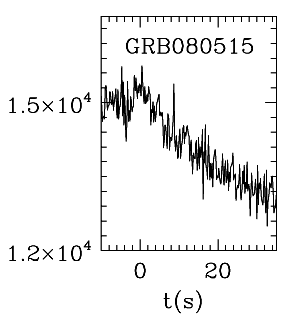GRB 080515
Time: 06:01:13
Trigger Number: 311658
Burst Advocate: Stephen Holland
BAT Data:
| RA: a | 3.166 00:12:39.8 |
| Dec: a | 32.564 32:33:50.4 |
| 90% Error Radius: b | 1.6 |
| T90: c | 21 |
| Fluence: d | 20 (3) |
| 1s Peak Photon Flux: e | 3.9 (0.7) |
| Photon Index: f | 0.94, CPL (1.21) |
90% error in parentheses,
a J2000;
b arcmin;
c seconds;
d 10-7 erg/cm2 (15-150 keV);
e ph/cm2/sec (15-150 keV);
f PL = simple power-law, CPL = cutoff power-law (15-150 keV)
BAT Light Curve:

XRT Data:
| RA: a | n/a |
| Dec: a | n/a |
| 90% Error Radius: b | n/a |
| Time to First Observation: c | n/a |
| Early Flux: d | n/a |
| 11 Hour Flux: d | 0.1366252 |
| 24 Hour Flux: d | 0.067298 |
| Initial Temporal Index: | -0.9076 |
| Spectral Index (Gamma): | 1.77465 |
| Column Density (NH): e | 0.46614915 |
Note: Please be aware that only the very basic temporal and spectral quantities are reported here. You are strongly encouraged to see the referenced GCN circulars for full details.
a J2000;
b arcsec;
c seconds;
d 10-11 erg/cm2/s (0.3-10 keV);
e 1021 cm-2
» XRT GRB Live Catalogue
» XRT Light Curves
» XRT Spectra
UVOT Data:
| RA: a | n/a |
| Dec: a | n/a |
| 90% Error Radius: b | n/a |
| Time to First Observation: c | 129600 |
| V Magnitude: | n/a |
| Other Filter Magnitudes: | n/a |
a J2000; b arcsec; c seconds
Other Burst Info:
Redshift:Host Galaxy:
Other Observatory Detections:
Kitt Peak (4m)
Comments:
This burst is only 45.9 degrees from the Sun, so there will be no prompt XRT or UVOT data.
BAT: burst can be classified as an X-ray flash.
UVOT: The XRT error circle is located in the scattered light halo of the B = 11.4 star (TYC 2264-1051-1), so it is not possible to constrain the presence of an afterglow in the UVOT data
References:
BAT: GCN 7721; GCN 7726
XRT: GCN 7762; Evans et al., 2009, MNRAS, 397, 1177
UVOT: GCN 7762
Radio:
Redshift:
Host:
Other: GCN Report 141.1
